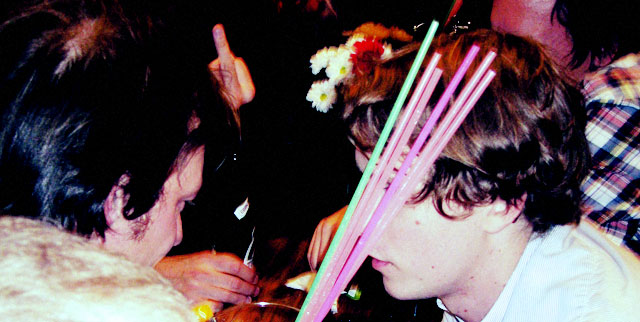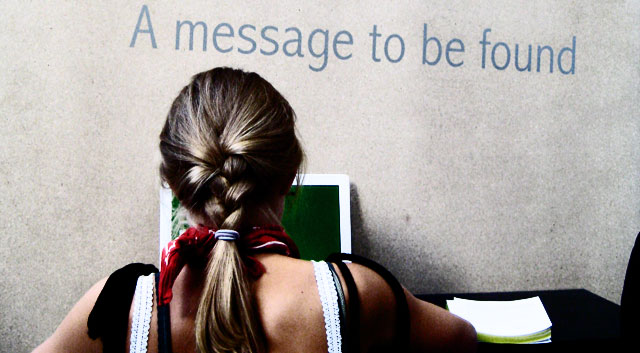We just got back from the alternative Copenhagen art fair. It’s too early to say if we were a smashing hit, but at least some people got smashed so let’s call that a partial win. It’s not always obvious what you take away from a happening like this. You’re supposed to hobnob and get to know others in your field and get invited to co-operating with galleries and such. Etc. Some of us did get invited to other spaces, and Skup Palet is more corporeal now than it was before, which is a good thing.
Because Skup Palet is such a diverse group I guess we all had different ambitions with our presence. I for one wanted to see what this whole art fair business was about — never been to one more than five minutes — and watch performance art or at least talk to performance artists. As therapy, you understand. There was a flesh-and-blood dadaist doing his thing, which was so quaint it went to bad and back to good again. There is little avant-garde left when nonsense poetry is regarded as something “classic.” Goodiepal did a performance in the shape of a lecture, a form I used for my MA and which Olle thinks is awesome; I found it “cool and stuff.”
We represented with Frustration Canon and A Message To Be Found (the latter a project that Olle and I put together) and visitors and other artists seemed to enjoy both. Both were interactive; The former more ambitious and the other taking the shape of the ubiquitous “laptop with a webpage,” where all the relational aesthetics in the world can’t hide the fact that the my Macbook was incidental to the situation. (Much like a movie on slavery needs a person of colour, any colour.)

Frustration Canon is an idea based on something that I threw together some years ago. Ever since I put that thing up, Anna has urged me to do something more with it, to take it a step further as she puts it. Which sounds like a good idea but I have no inkling of what it implies. To me it was only ever about making a webpage where three people bang their heads on a desk. When I envisage “taking it further” I can only imagine variations on a theme, but not all that much new content. More banging, banging on other surfaces, banging in high definition.
It’s flattering when someone likes ones work, and the art fair was an opportunity to make something more of the idea; Anna and Jan took the original concept and ran with it. Together with Pär, who set up the video playback in PD, they attached a contact microphone underneath a table and invited people to bang their foreheads on the red X, a vinyl sticker taped to the surface. There are other details to the setup, but that’s basically it: Invite people to booth, promise them it won’t hurt too much and put them on the big 42″ screen mounted prominently on a wall.
As it turns out, people are quite happy to hit their heads in exchange for a pin and a smile. I don’t reveal it that often, but when I apply myself I can become an intolerably cheerful fucker. With a manic grin, flattery and a kind of friendliness you wouldn’t believe, I raked clients in one after another, all the while most others of our troop looked like undertakers annoyed with the living, doing little to dispel the image of artists as brooding and difficult.
What made Frustration Canon a good choice of work to show as an introduction to Skup Palet is the overly symbolic gesture of literally “banging ones head in frustration” as it applies both to an artistic “struggle” as to working in a group, with all the inherent difficulties of organisation and egos getting trampled. Ten artists pulling together is more often than not an exercise in futility – it’s like herding cats; Angry, philosophical, drunk, cats. It takes a great deal of work to make teamwork work, and if you take away nothing else from the video then perhaps use it as an illustration of your own life as a member of any given collective. Originally, we had talked about letting the “bang” synchronise once every half hour or so, but that was a bit too complicated to pull off at such short notice.
The version below is a more recent edit, with people from Enrico Pallazzo banging their heads, synched to make a melody. I think Robert might have done the edit, I’m not sure. The look and sound of the piece is different from what we presented in Copenhagen, but the individual framing of the shots are more or less the same. In Copenhagen the videos were shown in a 4×4 grid, randomly appearing and occasionally in a different pitch.
My and Olles work, A message to be found, has the shape of a website service; You write a message and then hide it for as long as you like. It’s a delay of a day, a week or tens of years. You can add an image to your message, and are encouraged to tag what you’ve written. If you write a love letter to your boyfriend, you might tag the message “John Doe, love letter, Bombay 2009, honeymoon” and those keywords would end up somewhere on the generated page. The idea being that the search engines (today that means “the Google”) will index the page based on the keywords in lieu of the content – since the content won’t be visible for another n years. Until the message is revealed you only see a countdown timer.
It’s a message to be found but we don’t know by whom or under what circumstances. In five years time pages might be indexed differently. HTML 4 might only be accessible by legacy browsers when the whole Internet moves into the next iteration of Second Life or Facebook or smell-o-vision. The project is based on Flash which looking back hasn’t been the most search-friendly format, although that might resolve itself with time and more computing power thrown on the ambition of a semantic web.
There are similar services, like Future Me which allows you to delay messages, as well as services that send out notices if you don’t ping their server for a while (the service, assuming that you have died, sends out your missives from beyond the grave) but A message to be found differentiates itself by being a delayed public publication. The distinction is small, but it’s an interesting enough experiment and it’ll be fun to see what indexes will pick up the messages, and what messages have been written. Every once in a while Olle checks in on how many messages have been written, and there’s a small but steady stream of them being entered.
As an aside, Radio Lab recently made en episode where some of the above mentioned services come into play. It’s the After Life episode and you could jump to the end of the show if you want to hear that segment, or listen from the start to an excellent hour of excellence.
